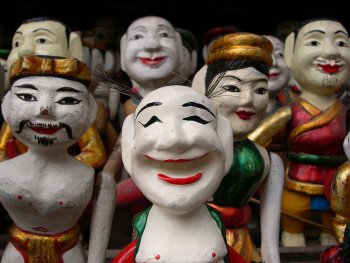Puppetry holds its own, even in a high-tech world.

Vietnamese water puppets. Photo: Danny Fay. Source: Wikimedia Commons.
It would be hard to count the number of people who have been blown up on the big screen in the last 18 months, the vehicles that have exploded, the human bodies mutilated, burned to death, shot through the heart. We are neither horrified at graphic representations of violence nor riveted by special effects. Computer-imaged suffering and gore have ceased to move, even to interest us.
Enter live puppetry and object theater (performance involving anything from a cloth that convulses in dance to a pencil sharpener that reads the evening news), which adult Americans are going to see in increasing numbers. Unlike human actors, puppets can be mutilated, burned, sent flying and transformed into inhuman things. But unlike what goes on in the movies, it is real. These live processes return the horror of the appalling and the surreal magic of the implausible. No other medium can exploit the sequencing, pacing and structure of the movies in live performance. And because it can be done for a song, puppetry allows individual artists to express themselves in the fantastical language usually co-opted by commerce.
When Woyzeck kills Maria in Woyzeck on the Highveld, a production mounted by the Handspring Puppet Company of South Africa, you gasp at the violence: it is as arresting as any news footage from that country. The puppetry presented by the French troupe Philippe Genty in New York in 1992 was so controlled, the use of false perspectives so masterful, that often you could not tell whether you were looking at a person or at an eight-inch puppet. Audience members underwent the startling experience of being erotically attracted to what turned out to be a puppet (without even a structured body), and rather bored by what turned out to be an extremely attractive woman. When Stuffed Puppet Theater of Amsterdam performed in New York in March, characters beat and scraped each other mercilessly; the terrifying mother in her electric wheelchair rolled silently across the stage; the strong abused the weak. Watching, you disliked the human actor and felt for his puppets, forgetting that they were only constructed extensions of himself.
Some puppeteers choose to be invisible, but others lay bare their craft. Though you watch the American puppeteer Roman Paska manipulate his figures (miniature self-portraits), they become wholly animate: you can see his mouth move, watch his hand raising a puppet’s arm, but his almost aggressive visibility never compromises the illusionism of his work. In New York, Ninth Street Theater’s Terror as Usual — performed regularly at P.S. 122 — connects current events to East Village life with a dry humor (visual and verbal) that could not be approximated in any other medium. The Bread and Puppet Theater of Vermont, with its massive symbolic figures and outdoor parades, is the American answer to a well-established European tradition of politicized puppetry. When live theater was censored in Eastern Europe, some directors moved into puppetry, where they could work without danger. Associations between puppetry and childhood innocence make it most powerful when it is subverted — and subversion has become its rule.
It is striking how broad a range of work recent American puppetry festivals have encompassed: traditional crafts from non-Western societies sit comfortably beside the avant-garde Western work they have influenced. The International Festival of Puppet Theater, which will open at the Public Theater in New York on Sept. 6, features 16 companies from nine countries. It promises to be more imaginative than Broadway, and greater in its impact than the movies.











